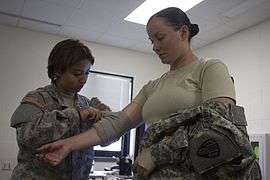Emergency Bandage

The Emergency Bandage or Israeli bandage is a specially designed, first-aid device that is used to stop bleeding from hemorrhagic wounds caused by traumatic injuries in pre-hospital emergency situations.[1][2] First used for saving lives during a NATO peacekeeping operation in Bosnia and Herzegovina, the bandages were successfully used during operations Enduring Freedom and Iraqi Freedom.[1][2] The emergency bandages were nicknamed "Israeli bandage" by American soldiers,[3] and have been "the bandages of choice for the US Army and special forces."[2] Israeli bandages were included in the first aid kits of emergency personnel and first responders at the 2011 Tucson shooting, and were used to treat some victims of the shooting.[1][4]
The bandage was invented by an Israeli military medic, Bernard Bar-Natan. The bandages are being manufactured in Lod, Israel, by First Care Products Ltd.[1]
Background
For years, one of the most preventable causes of deaths in non-fatally wounded people has been the inability to quickly and effectively stop bleeding.[3] Military doctors Nolan Shipman and Charles S. Lessard write in Military Medicine journal that "[t]he first step in containing seriously wounded casualties is to control the hemorrhage as much as possible."[2] The US military used to take wounded soldiers from battlefields to hospitals for treatment. This often resulted in an irreversible loss of blood. Today, the tactic of caring for wounded soldiers has changed and the wounds are treated on the spot. Israeli bandages that can be applied with only one hand are successfully used to stop bleeding by the armies of the US, Australia, New Zealand, and other countries.[3] David Kleinman, a SWAT team medic who devised a first aid kit used to treat victims of the 2011 Tucson shooting, said that "deputies reached for the emergency bandage 'over and over at the scene'" of the shooting.[4]
History of development
When the bandage's inventor, Bernard Bar-Natan, was in training to become a military medic in 1984, he noticed that some of the bandages they used to stop bleeding had a manufacture date of 1942 or sometimes even 1938, and also that the other bandages that were manufactured a month earlier than use had the same design and the same features as 1942 bandages did.[1][5] The students were advised to grab a stone and to use it to apply a pressure to a wound that would not clot on its own. Bar-Natan started work on a new generation of bandages that would not rely on the "grab a stone" approach, but would have a pressure bar built into the bandages themselves.[1] In 1990–1991, the idea and the design were developed enough to apply for Government support from the Office of the Chief Scientist in the Ministry of Industry. The application allowed Bar-Natan to become a part of a technology incubator program in Jerusalem’s Har Hotzvim, with a government grant covering 3/4 of the expenses connected to the research and development of the bandage.[1] It took three more years to develop the bandages enough to try to sell them. It was not an easy task not only because the emergency bandages were an unproven product, but also because their inventor had no prior business record.[1] A Belgian medical equipment distributor bought the first bandages in 1998.[1] Today, the four-person startup company produces 1.5 to 2 million bandages a year.[1]
Bandages
"The emergency bandage is an elasticized bandage with a non-adhesive bandage pad sewn in. The bandage has a built-in pressure bar, which allows the soldier to twist the bandage around the wound once, and then change the direction of the bandage, wrapping it around the limb or body part, to create pressure on the wound. Aside from this, the pressure bar also makes bandaging easier. A closure bar at the end of the bandage means that it clips neatly into place and will not slip."[3]
The bandages come in three different sizes: 4, 6, and 8 inches wide.[2] They are similar to elastic bandages that are used to treat sprain injuries, but they have three features that are unique to them:
- the sterile non-adhering dressing that is designed to allow removing the bandage without reopening a wound.[2]
- the pressure applicator or the pressure bar that is placed directly over the wound to stop the bleeding by applying pressure.[2] It allows to wrap the bandage around a wound in different directions. This is a useful feature for stopping bleeding in groin and head injuries.[3]
- the closure bar that is used to secure the bandage and to apply additional pressure to a wound. The closure bar can be used by a "simple sliding motions with one hand."[2]
Military doctors Nolan Shipman and Charles S Lessard write in Military Medicine journal that "The emergency bandage's sterile, nonadherent pad applies pressure to any site, can be easily wrapped and secured, and has an additional application, similar to a tourniquet, to further constrict blood flow".[2]
The bandage is of a general type called combat compression bandages; another make is the Olaes modular bandage.[6]
See also
References
- 1 2 3 4 5 6 7 8 9 10 David Horowitz (2011-04-29). "Editor's Notes: The guy with the bandage". The Jerusalem Post. Retrieved May 17, 2011.
- 1 2 3 4 5 6 7 8 9 Nolan Shipman; Charles S Lessard (January 2009). "Pressure Applied by the Emergency/Israeli Bandage" (PDF). Military Medicine. pp. 86–92(7). Retrieved April 4, 2011.
- 1 2 3 4 5 Nicky Blackburn (January 9, 2005). "Israeli innovative bandages saving American lives in Iraq". israel21c. Retrieved April 4, 2011.
- 1 2 Sandhya Somashekhar; Sari Horwitz (January 21). "First-aid kits credited with saving lives in Tucson shooting". Washington Post. Retrieved May 17, 2011. Check date values in:
|date=(help) - ↑ Ron Kampeas (February 17, 2011). "‘Israeli bandage’ may have saved Giffords’ life after shooting". j. Retrieved April 4, 2011.
- ↑ Wipfler III, E. John; Wipler, E. John; Campbell, John E.; Lawrence E. Heiskell (2010). Tactical Medicine Essentials. Jones & Bartlett Learning. p. 158. ISBN 0-7637-7821-4.